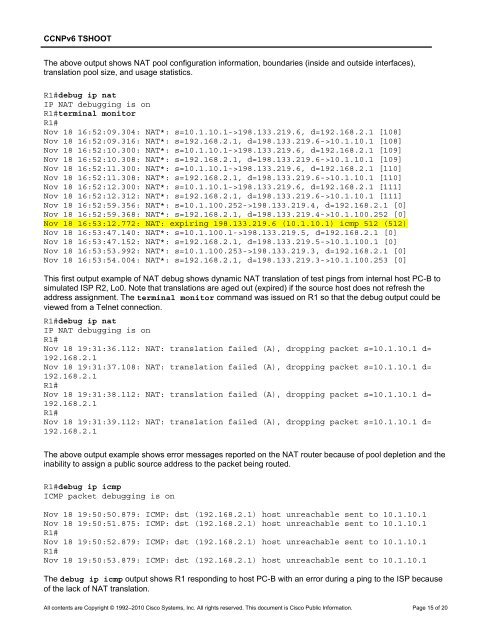CCNP TSHOOT 6.0 - The Cisco Learning Network
CCNP TSHOOT 6.0 - The Cisco Learning Network
CCNP TSHOOT 6.0 - The Cisco Learning Network
You also want an ePaper? Increase the reach of your titles
YUMPU automatically turns print PDFs into web optimized ePapers that Google loves.
<strong>CCNP</strong>v6 <strong>TSHOOT</strong><br />
<strong>The</strong> above output shows NAT pool configuration information, boundaries (inside and outside interfaces),<br />
translation pool size, and usage statistics.<br />
R1#debug ip nat<br />
IP NAT debugging is on<br />
R1#terminal monitor<br />
R1#<br />
Nov 18 16:52:09.304: NAT*: s=10.1.10.1->198.133.219.6, d=192.168.2.1 [108]<br />
Nov 18 16:52:09.316: NAT*: s=192.168.2.1, d=198.133.219.6->10.1.10.1 [108]<br />
Nov 18 16:52:10.300: NAT*: s=10.1.10.1->198.133.219.6, d=192.168.2.1 [109]<br />
Nov 18 16:52:10.308: NAT*: s=192.168.2.1, d=198.133.219.6->10.1.10.1 [109]<br />
Nov 18 16:52:11.300: NAT*: s=10.1.10.1->198.133.219.6, d=192.168.2.1 [110]<br />
Nov 18 16:52:11.308: NAT*: s=192.168.2.1, d=198.133.219.6->10.1.10.1 [110]<br />
Nov 18 16:52:12.300: NAT*: s=10.1.10.1->198.133.219.6, d=192.168.2.1 [111]<br />
Nov 18 16:52:12.312: NAT*: s=192.168.2.1, d=198.133.219.6->10.1.10.1 [111]<br />
Nov 18 16:52:59.356: NAT*: s=10.1.100.252->198.133.219.4, d=192.168.2.1 [0]<br />
Nov 18 16:52:59.368: NAT*: s=192.168.2.1, d=198.133.219.4->10.1.100.252 [0]<br />
Nov 18 16:53:12.772: NAT: expiring 198.133.219.6 (10.1.10.1) icmp 512 (512)<br />
Nov 18 16:53:47.140: NAT*: s=10.1.100.1->198.133.219.5, d=192.168.2.1 [0]<br />
Nov 18 16:53:47.152: NAT*: s=192.168.2.1, d=198.133.219.5->10.1.100.1 [0]<br />
Nov 18 16:53:53.992: NAT*: s=10.1.100.253->198.133.219.3, d=192.168.2.1 [0]<br />
Nov 18 16:53:54.004: NAT*: s=192.168.2.1, d=198.133.219.3->10.1.100.253 [0]<br />
This first output example of NAT debug shows dynamic NAT translation of test pings from internal host PC-B to<br />
simulated ISP R2, Lo0. Note that translations are aged out (expired) if the source host does not refresh the<br />
address assignment. <strong>The</strong> terminal monitor command was issued on R1 so that the debug output could be<br />
viewed from a Telnet connection.<br />
R1#debug ip nat<br />
IP NAT debugging is on<br />
R1#<br />
Nov 18 19:31:36.112: NAT: translation failed (A), dropping packet s=10.1.10.1 d=<br />
192.168.2.1<br />
Nov 18 19:31:37.108: NAT: translation failed (A), dropping packet s=10.1.10.1 d=<br />
192.168.2.1<br />
R1#<br />
Nov 18 19:31:38.112: NAT: translation failed (A), dropping packet s=10.1.10.1 d=<br />
192.168.2.1<br />
R1#<br />
Nov 18 19:31:39.112: NAT: translation failed (A), dropping packet s=10.1.10.1 d=<br />
192.168.2.1<br />
<strong>The</strong> above output example shows error messages reported on the NAT router because of pool depletion and the<br />
inability to assign a public source address to the packet being routed.<br />
R1#debug ip icmp<br />
ICMP packet debugging is on<br />
Nov 18 19:50:50.879: ICMP: dst (192.168.2.1) host unreachable sent to 10.1.10.1<br />
Nov 18 19:50:51.875: ICMP: dst (192.168.2.1) host unreachable sent to 10.1.10.1<br />
R1#<br />
Nov 18 19:50:52.879: ICMP: dst (192.168.2.1) host unreachable sent to 10.1.10.1<br />
R1#<br />
Nov 18 19:50:53.879: ICMP: dst (192.168.2.1) host unreachable sent to 10.1.10.1<br />
<strong>The</strong> debug ip icmp output shows R1 responding to host PC-B with an error during a ping to the ISP because<br />
of the lack of NAT translation.<br />
All contents are Copyright © 1992–2010 <strong>Cisco</strong> Systems, Inc. All rights reserved. This document is <strong>Cisco</strong> Public Information. Page 15 of 20

















